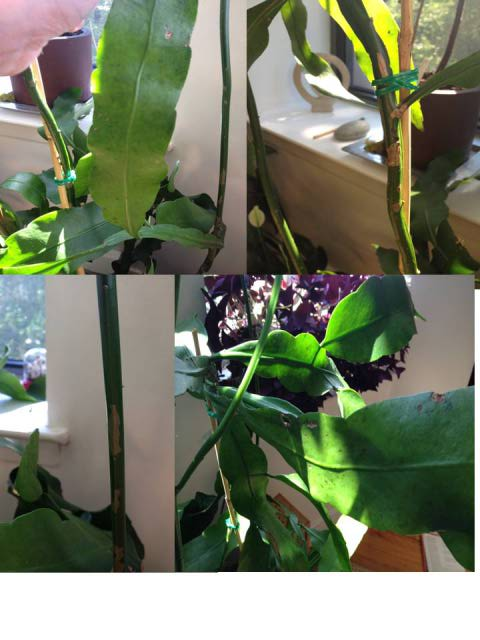Question Epiphyllum oxypetalum
Epiphyllum oxypetalum
QUESTION: Hi Melissa, thank you so very much for taking the time to answer my question. I have been growing an Epiphyllum oxypetalum indoor for the past two years and it got diseased about 4 months ago (see photo). All parts are affected.I have used some organic pest treatment, with no effect. And I am afraid the disease spread to the plant next to it. Could you please let me know what disease it is and how to treat/prevent it? With many thanks. Laurence
ANSWER: Dear Laurence, After looking at your pictures, I walked into my back yard to look at my plant, and sure enough it has the same nicks and markings as your plant. Surprisingly, this is actually not a disease. The leaves (I believe they are actually specialized stems) of this plant are very long and floppy, and because of this, they get nicked frequently. Just having a bird land on this plant and fly back off will often cause a scratch or hole on the leaves and they stay scarred. If you'll notice on the part that is tied by plant ties, the area under the tie is scarred simply because the tie and the stake rub against the plant. I have never known anyone to treat this symptom; it is simply part of the way this plant grows. Another example would be the banana tree. The leaves are long and smooth, but any wind that comes up will cause the leaves to split and tear. This is just how the banana plant will survive high winds which are common in tropical regions where they grow. You could conceivably spray the plant with NEEM, an organic substance which works as an insecticide, fungicide, and miticide (spider mites), and you can spray the plant with this and also surrounding plants in case you think there is something wrong with them. I wouldn't worry though. I'm sure your cereus is fine. My particular plant comes from a cutting off of a plant that has been in my family for well over 50 years and that plant still looks spectacular and still blooms a lot. You may have had something chewing on it a bit, and you could also consider spraying the plant with Spinosad, another organic ingredient which will kill anything that comes later to feed on it. Keep in mind that NEEM and Spinosad are ingredients, not brand names. Also be sure not to overwater this plant, although it is pretty forgiving. So relax and enjoy your plant, and be glad that you are one of the few diligent gardeners who are likely to notice as soon as problems do arise. Feel free to write back if you have more questions. I hope this information helped. Good luck, Melissa
---------- FOLLOW-UP ----------
QUESTION: Dear Melissa, Thank you do very muchfor your careful and detailed answer. It is really much appreciated.
Could you please confirm however that the small "dots" and "stains" on the leaves (with my lay vocabulary) are not a disease ? Thanks for your time. Regards, Laurence.
AnswerDear Laurence, I absolutely guarantee that these knicks and dots and scrapes are not a disease. They are on my cereus, they are on the parent cereus (over 50 years old, remember), and they are on every single cereus that I have ever seen, and I have seen quite a few. You can make these spots yourself although you probably don't want to, but if you scrape the side of a leaf with your fingernail, you will see a scab start to form after just a short period of time. I believe the plant does this to prevent water loss. Please feel free to write with any question you may have about any plants. Melissa






